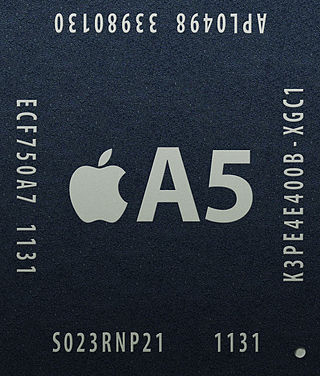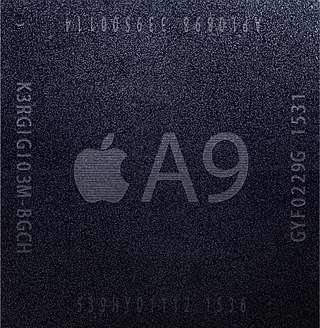
The Apple A4 is a 32-bit package on package (PoP) system on a chip (SoC) designed by Apple Inc. and manufactured by Samsung. It was the first SoC Apple designed in-house. The first product to feature the A4 was the first-generation iPad, followed by the iPhone 4, fourth-generation iPod Touch, and second-generation Apple TV.

The Apple A5 is a 32-bit system on a chip (SoC) designed by Apple Inc. and manufactured by Samsung. The first product Apple featured an A5 in was the iPad 2. Apple claimed during their media event on March 2, 2011, that the ARM Cortex-A9 central processing unit (CPU) in the A5 is up to two times faster than the CPU in the Apple A4, and the PowerVR SGX543MP2 graphics processing unit (GPU) in the A5 is up to nine times faster than the GPU in the A4. Apple also claimed that the A5 uses the same amount of power as the A4.

Apple silicon is a series of system on a chip (SoC) and system in a package (SiP) processors designed by Apple Inc., mainly using the ARM architecture. They are the basis of Mac, iPhone, iPad, Apple TV, Apple Watch, AirPods, AirTag, HomePod, and Apple Vision Pro devices.

The Apple A5X is a 32-bit system on a chip (SoC) designed by Apple Inc. and manufactured by Samsung. Apple used it only in the third-generation iPad. The A5X is a high-performance variant of the Apple A5. Apple claimed during their media event on March 7, 2012 that the quad-core PowerVR SGX543MP4 graphics processing unit (GPU) in the A5X is two times faster than the GPU in the A5, as the A5X GPU contains two more cores than the dual-core version GPU in the A5.
The Apple A7 is a 64-bit system on a chip (SoC) designed by Apple Inc. It first appeared in the iPhone 5S, which was announced on September 10, 2013, and the iPad Air and iPad Mini 2, which were both announced on October 22, 2013. Apple states that it is up to twice as fast and has up to twice the graphics power compared to its predecessor, the Apple A6. It is the first 64-bit SoC to ship in a consumer smartphone or tablet computer. On March 21, 2017, the iPad mini 2 was discontinued, ending production of A7 chips. The latest software update for systems using this chip was iOS 12.5.7, released on January 23, 2023, as they were discontinued with the release of iOS 13 and iPadOS 13 in 2019.

The Apple A6X is a 32-bit system-on-a-chip (SoC) designed by Apple Inc., introduced at the launch of the 4th generation iPad on October 23, 2012. It is a high-performance variant of the Apple A6 and the last 32-bit chip Apple used on an iOS device before Apple switched to 64-bit. Apple claims the A6X has twice the CPU performance and up to twice the graphics performance of its predecessor, the Apple A5X. Software updates for the 4th generation iPad ended in 2019 with the release of iOS 10.3.4 for cellular models, thus ceasing support for this chip as it was discontinued with the release of iOS 11 in 2017.

The Motorola RAZR i (XT890) is a smartphone designed by Motorola Mobility. It was officially announced on 18 September 2012 in London, UK.

The Apple M-series coprocessors are motion coprocessors used by Apple Inc. in their mobile devices. First released in 2013, their function is to collect sensor data from integrated accelerometers, gyroscopes and compasses and offload the collecting and processing of sensor data from the main central processing unit (CPU).
This is a comparison of ARM instruction set architecture application processor cores design by ARM Holdings and 3rd parties. This doesn't include ARM Cortex-R, ARM Cortex-M, or legacy ARM cores.
James B. Keller is an American microprocessor engineer best known for his work at AMD and Apple. He was the lead architect of the AMD K8 microarchitecture and was involved in designing the Athlon (K7) and Apple A4/A5 processors. He was also the coauthor of the specifications for the x86-64 instruction set and HyperTransport interconnect. From 2012 to 2015 he returned to AMD to work on the AMD K12 and Zen microarchitectures.

The Apple A9 is a 64-bit ARM-based system-on-chip (SoC), designed by Apple Inc. Manufactured for Apple by both TSMC and Samsung, it first appeared in the iPhone 6S and 6S Plus which were introduced on September 9, 2015. Apple states that it has 70% more CPU performance and 90% more graphics performance compared to its predecessor, the Apple A8. On September 12, 2018, the iPhone 6S and iPhone 6S Plus along with the first-generation iPhone SE was discontinued, ending production of A9 chips. The latest software updates for the iPhone 6S & 6S Plus including the iPhone SE 1st generation variants systems using this chip are iOS 15.7.6, released on May 18, 2023 as they were discontinued with the release of iOS 16 in 2022, and for the iPad 5th generation using this chip was iPadOS 16.5, released on May 18, 2023, as it was discontinued with the release of iPadOS 17 in 2023.

The Apple A9X is a 64-bit ARM architecture-based system on a chip (SoC) designed by Apple Inc. It first appeared in the iPad Pro, which was announced on September 9, 2015 and was released on November 11, 2015. The A9X has the M9 motion coprocessor embedded in it, something not seen in previous chip generations. It is a variant of the A9 and Apple claims that it has 80% more CPU performance and twice the GPU performance of its predecessor, the A8X. The latest software update for the iPad Pro 12.9 1st generation & 9.7 using this chip was iPadOS 16.5, released on May 18, 2023, as it was discontinued with the release of iPadOS 17 in 2023 due to hardware limitations of the A9X.

The Apple A10 Fusion is a 64-bit ARM-based system on a chip (SoC), designed by Apple Inc. and manufactured by TSMC. It first appeared in the iPhone 7 and 7 Plus which were introduced on September 7, 2016, and is used in the sixth generation iPad, seventh generation iPad, and seventh generation iPod Touch. The A10 is the first Apple-designed quad-core SoC, with two high-performance cores and two energy-efficient cores. Apple states that it has 40% greater CPU performance and 50% greater graphics performance compared to its predecessor, the Apple A9. The Apple T2 chip is based on the A10. On May 10, 2022, the iPod Touch 7th generation was discontinued, ending production of A10 Fusion chips. The latest software updates for the iPhone 7 & 7 Plus including the iPod Touch 7th generation variants systems using this chip are iOS 15.7.7, released on June 21, 2023 as they were discontinued with the release of iOS 16 in 2022, while updates for the iPad variants systems using this chip are still supported.

The Apple A11 Bionic is a 64-bit ARM-based system on a chip (SoC), designed by Apple Inc. and manufactured by TSMC. It first appeared in the iPhone 8 and 8 Plus, and iPhone X which were introduced on September 12, 2017. Apple states that the two high-performance cores are 25% faster than the Apple A10's and the four high-efficiency cores are up to 70% faster than the two corresponding cores in the A10. The A11 Bionic chip was discontinued on April 15, 2020, following the discontinuation of the iPhone 8 and 8 Plus. The latest software update for the iPhone 8 & 8 Plus including the iPhone X using this chip was iOS 16.6, released on July 24, 2023, as it was discontinued with the release of iOS 17 in 2023 due to hardware limitations of the A11.

The Apple A12 Bionic is a 64-bit ARM-based system on a chip (SoC) designed by Apple Inc. It first appeared in the iPhone XS and XS Max, iPhone XR, iPad Air, iPad Mini, 8th generation iPad and Apple TV 4K. Apple states that the two high-performance cores are 15% faster and 50% more energy-efficient than the Apple A11's, and the four high-efficiency cores use 50% less power than the A11's. It is the first mass-market system on a chip to be built using the 7 nm process.

The Apple A12X Bionic is a 64-bit system on a chip (SoC) designed by Apple Inc. It first appeared in the iPad Pro, announced on October 30, 2018. The A12X is an 8-core variant of the A12 and Apple states that it has 35 percent faster single-core CPU performance and 90 percent faster overall CPU performance than its predecessor, the Apple A10X. The Apple A12Z Bionic is an updated version of the A12X, adding an additional GPU core, and was unveiled on March 18, 2020 as part of the iPad Pro.

The Apple A14 Bionic is a 64-bit ARMv8.5-A system on a chip (SoC), designed by Apple Inc. It appears in the fourth generation iPad Air and tenth generation iPad, as well as iPhone 12 Mini, iPhone 12, iPhone 12 Pro, and iPhone 12 Pro Max. Apple states that the central processing unit (CPU) performs up to 40% faster than the A12, while the graphics processing unit (GPU) is up to 30% faster than the A12. It also includes a 16-core neural engine and new machine learning matrix accelerators that perform twice and ten times as fast, respectively.

The Apple A15 Bionic is a 64-bit ARM-based system on a chip (SoC) designed by Apple Inc. It is used in the iPhone 13 and 13 Mini, iPhone 13 Pro and 13 Pro Max, iPad Mini, iPhone SE, iPhone 14 and 14 Plus and Apple TV 4K.
















